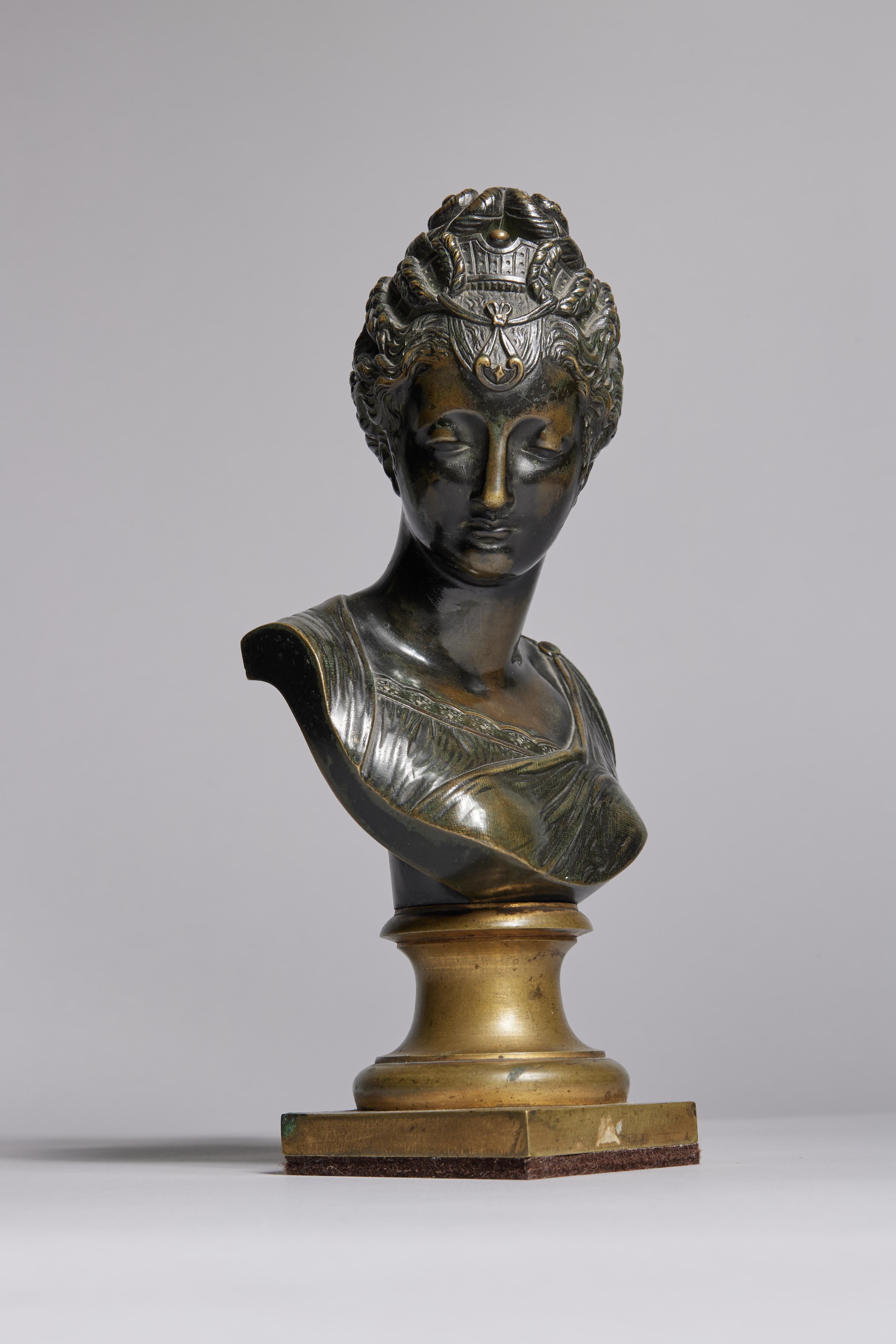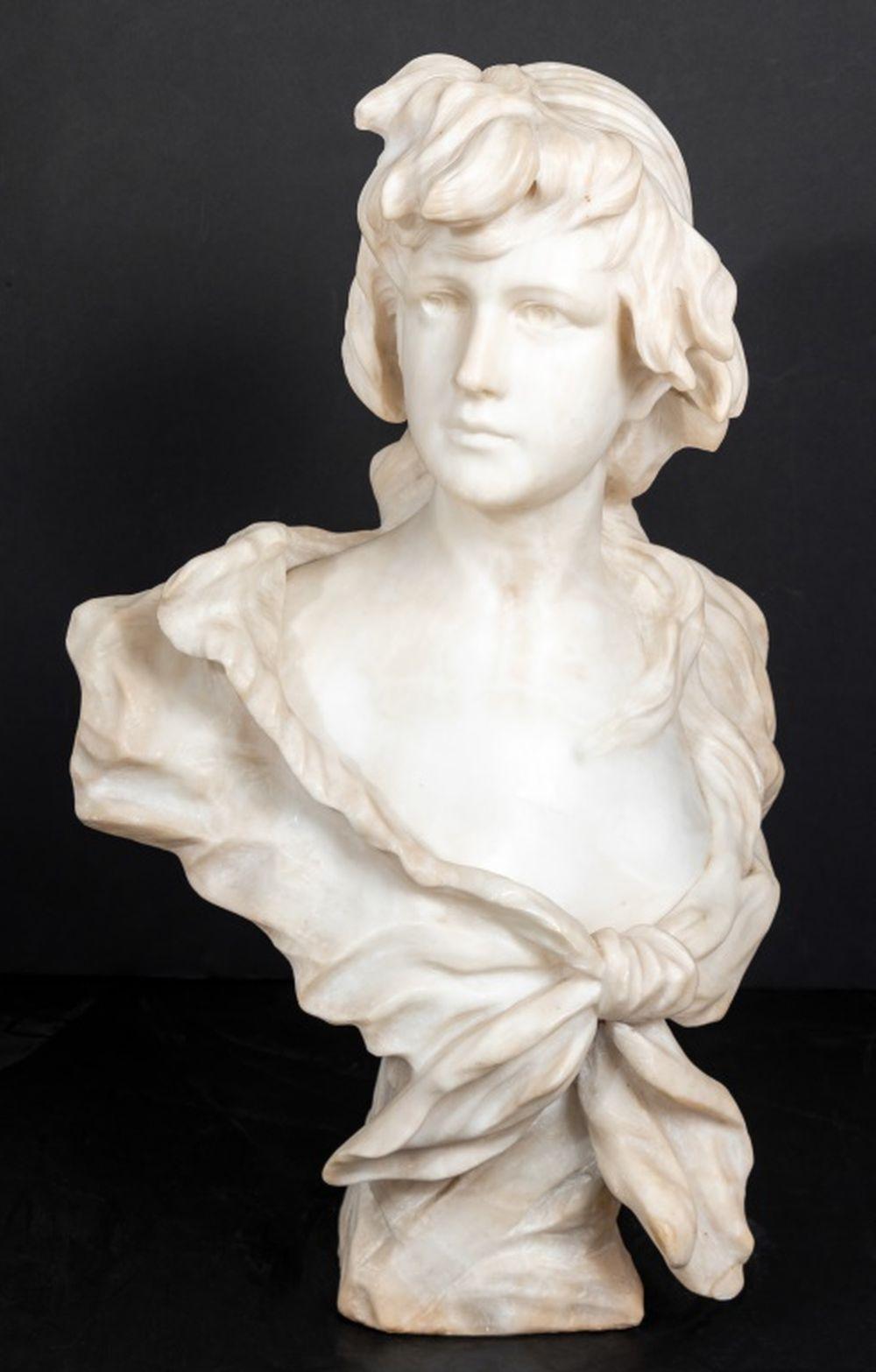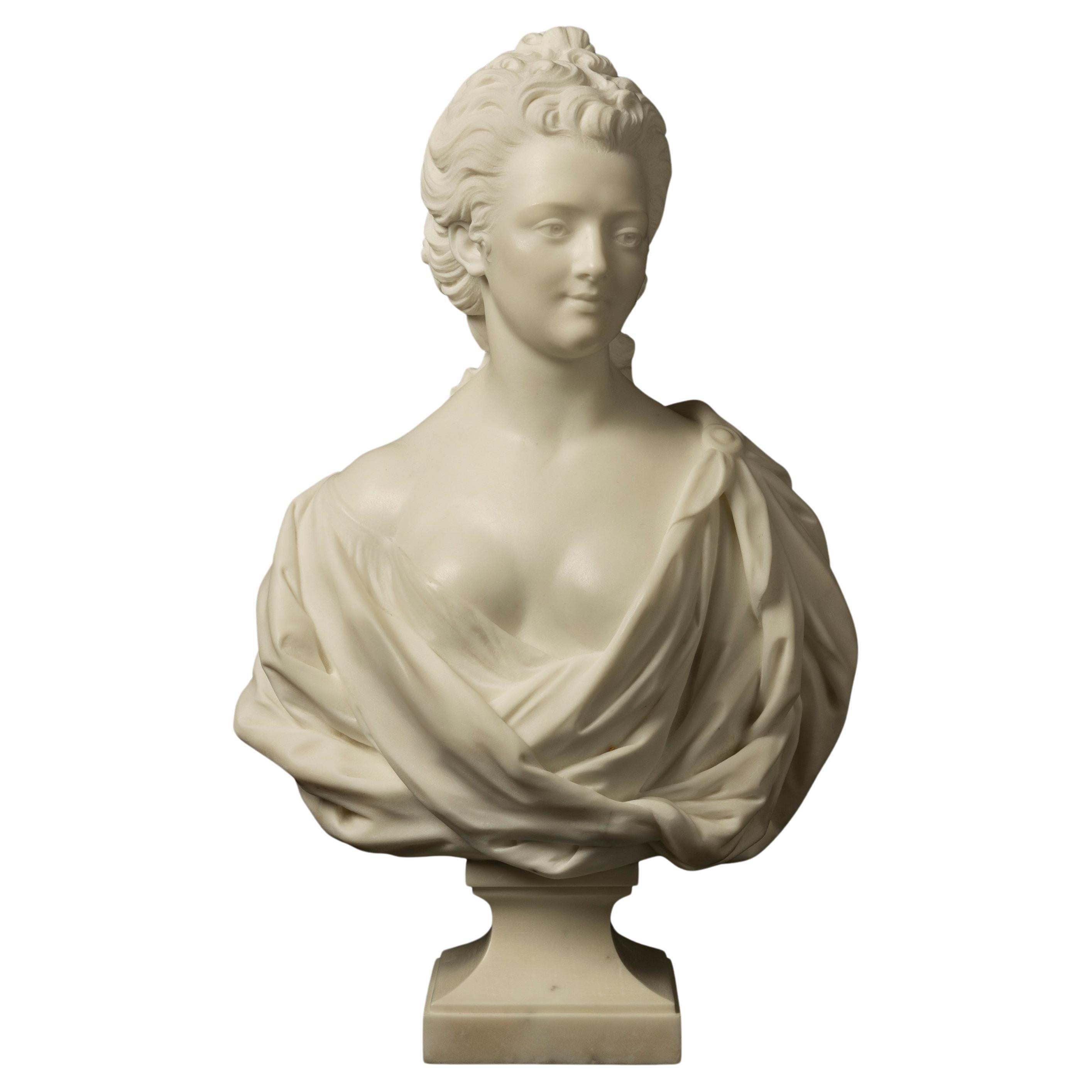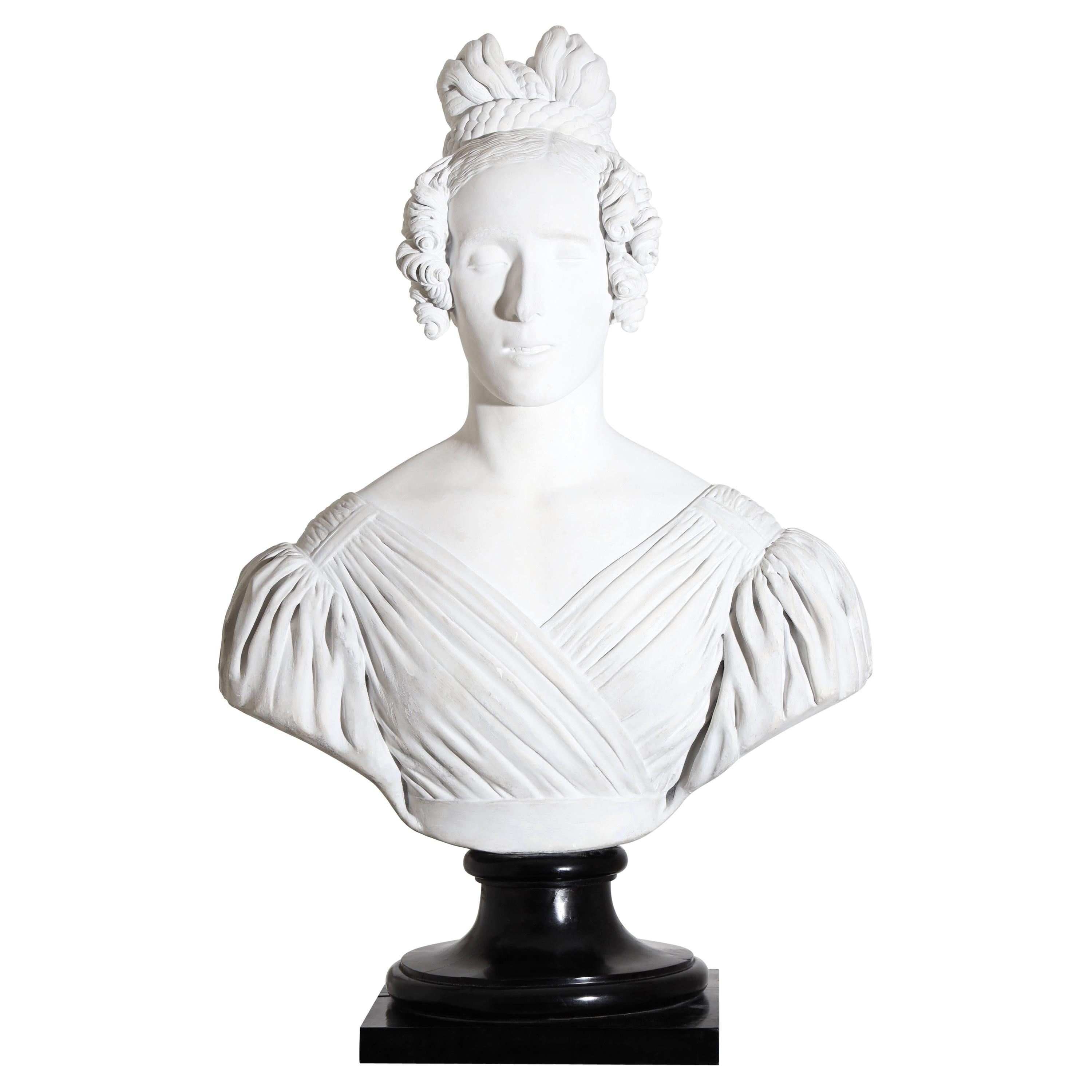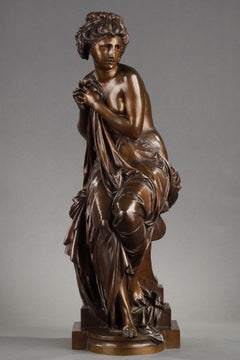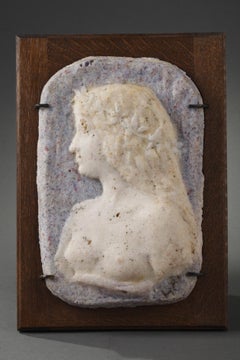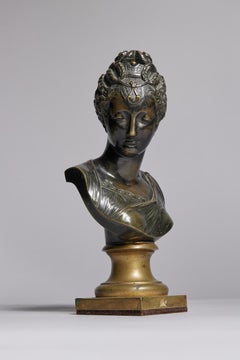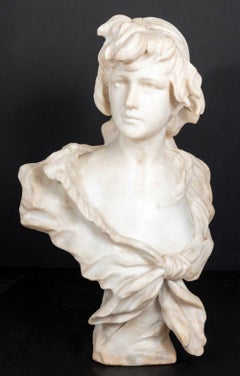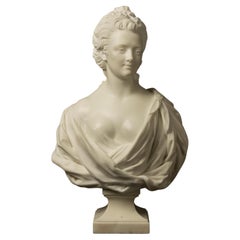Items Similar to Portrait of a Lady
Want more images or videos?
Request additional images or videos from the seller
1 of 17
Charles CordierPortrait of a Ladycirca 1860
circa 1860
$142,522.63
£106,830.54
€120,000
CA$197,087.42
A$214,577.93
CHF 114,577.79
MX$2,590,291.74
NOK 1,440,447.69
SEK 1,339,783.96
DKK 914,268.40
About the Item
Portrait of a Lady
by Charles CORDIER (1827-1905)
A rare bust in white Carrara marble
and onyx for the drape
Signed on the backside " C. Cordier "
Presented on a rounded white marble base
France
circa 1860
height 59 cm
width 44 cm
depth 22 cm
Although Charles Cordier was primarily known for his ethnographic sculptures, he was also one of the great portraitists of the Second Empire. Among the 612 works comprising his catalogue raisonné, 102 are ceremonial portraits commissioned by the French intelligentsia. Our bust combines marble with the onyx that Cordier used for his ethnographic works.
Biography :
Henri Joseph Charles Cordier, known as Charles Cordier (1827-1905) was a French sculptor whose subjects are representative of the orientalist style and eclecticism specific to the Second Empire. Son of a pharmacist, Charles Cordier entered the Paris School of Fine Arts in 1846. But he did not stay there long, because the same year he entered the workshop of his master François Rude. There he then made the decisive encounter with a former freed Sudanese slave who had become a professional model, Seïd Enkess, whose bust he created in two weeks. This was the start of his ethnographic work. His genre had the relevance of a new subject, the revolt against slavery, anthropology at its birth.
From then on, he produced a large quantity of orientalist statues, particularly busts. From the year of the abolition of slavery in 1848, Charles Cordier produced several series of portraits of Saïd Abdallah, from the Mayac tribe, Kingdom of Darfur or "Negro of Timbuktu" or "Nubian Negro". Queen Victoria acquired this bronze during the Universal Exhibition of 1851. From 1851, he sculpted a series of busts of an African Venus. His submissions to the Salon of 1853 caused a sensation. With his bronze busts of a Mongolian or Chinese man and woman (1853), he sought to obtain richer polychrome effects, a trend to which he remained faithful from then on, hence new colored African busts such as the famous "Negro of the Sudan" (between 1856 and 1857), acquired by Napoleon III in 1857, preserved in Paris at the Musée d'Orsay.
In 1855, his sending of two Chinese in gilded, silvered and enameled bronze to the Universal Exhibition in Paris was very noted. He used marble from Paros, onyx cut for draperies, enamels on copper, silver, gold. Charles Cordier dyed Carrara marble using different processes and used semi-precious stones, while modeling in a classic style. Thanks to grants awarded by the government, the artist could study in situ to “fix the different human types which are at the moment of blending into one and the same people”. He traveled to Italy, Algeria (1856), Greece (1858) in the Cyclades archipelago and Egypt (1866 and 1868).
At the Salon of 1857, Charles Cordier exhibited 18 busts, twelve of which were studies of Algerians, most of them in bronze. He perfected the polychromy of his works by sending to the Salon of 1863 the bust of an "Algerian Jewish Woman" in enameled bronze, onyx and porphyry; in 1864 a “Young Mulatto” in bronze, enamel and onyx; in 1866 a life-size statue of an "Arab Woman" in bronze, enamel and onyx, acquired by Empress Eugénie for her Chinese museum in Fontainebleau; and in 1867 the bust of a "Fellah" in bronze, gold, silver, turquoise and porphyry. In 1860, refused by an indignant sculpture jury, he appealed to the superintendent Émilien de Nieuwerkerke, to Princess Mathilde and to Napoleon III himself. The emperor, to temporize, decorated him.
However, his abundant work was not limited to ethnological representations. Charles Cordier more classically created busts of personalities such as those of Admiral Courbet (1885 and 1886), General Fleury (1863), or his relatives, as well as religious sculptures such as a 12th century Virgin (1889), or of Venus and other Priestess. For the major Parisian projects of the Second Empire, Cordier participated in those of the Louvre Palace, the Garnier Opera and the town hall. Charles Cordier also created, among others, the Monument to Marshal Gérard (1856, Verdun), the Triumph of Amphitrite (1861), the statue of Jean-Baptiste for the Saint-Jacques tower in Paris (around 1854), or the caryatids of Harmony and Poetry of the west chimney of the grand foyer of the Palais Garnier in Paris (1872).
The city of Cairo retains its Monument to Ibrahim Pasha, an equestrian statue that he created in 1872. For Mexico, Charles Cordier created a Monument to Christopher Columbus around 1872, flanked at the corners by four statues of Dominicans and Franciscans who had helped in his divine mission, the bas-reliefs adorning the pedestal representing virgin forests and the construction of a cathedral.
Charles Cordier was the author of 617 listed works, including 365 ethnographic busts and 103 bourgeois portraits. He obtained a third class medal at the Salon of 1851, a second class in 1853, with recall in 1857. He was named knight of the Legion of Honor on August 6, 1860.
- Creator:Charles Cordier (1827 - 1905, French)
- Creation Year:circa 1860
- Dimensions:Height: 23.23 in (59 cm)Width: 17.33 in (44 cm)Depth: 8.67 in (22 cm)
- Medium:
- Movement & Style:
- Period:
- Condition:
- Gallery Location:PARIS, FR
- Reference Number:Seller: N.80021stDibs: LU2514216234902

About the Seller
5.0
Recognized Seller
These prestigious sellers are industry leaders and represent the highest echelon for item quality and design.
Established in 1992
1stDibs seller since 2023
11 sales on 1stDibs
Typical response time: 6 hours
- ShippingRetrieving quote...Shipping from: PARIS, France
- Return Policy
More From This Seller
View AllLa Rieuse napolitaine
Located in PARIS, FR
La Rieuse napolitaine
(The Laughing Neapolitan Woman)
by Jean-Baptiste CARPEAUX (1827-1875)
Bust in terra cotta, in "Propriété Carpeaux"
Signed on the side " JBte Carpeaux "
Marked...
Category
1870s French School Figurative Sculptures
Materials
Terracotta
Portrait of a woman
Located in PARIS, FR
Portrait of a woman
by Marcel GIMOND (1894-1961)
Bronze with a nuanced dark brown patina
signed on the neck with the monogram "MG"
period cast by "Meroni Radice, cire perdue, Paris"...
Category
1930s French School Figurative Sculptures
Materials
Bronze
Susanna
By Albert-Ernest Carrier-Belleuse
Located in PARIS, FR
Susanna
by Albert-Ernest Carrier-Belleuse (1824-1887)
Bronze sculpture with nuanced brown patina
signed to the side " A. Carrier "
old period cast
France
circa 1860
height 62 cm
...
Category
1860s French School Figurative Sculptures
Materials
Bronze
Profile of young woman
Located in PARIS, FR
Profile of young woman
by Henry CROS (1840-1907)
Polychrome glass paste
presented on a wooden panel
France
circa 1900
height 24,5 cm
width 16,5 cm
panel : 29 x 21 cm
Biography :
...
Category
Early 20th Century French School Figurative Sculptures
Materials
Glass
The Lily
Located in PARIS, FR
The Lily
by Auguste CLESINGER (1814-1883)
Outstanding bust sculpted in white Carrara marble
Signed on the ribbon " J. Clésinger, 1871 "
Presented on a rounded white marble base
France
1871
height 76,5 cm
width 48 cm
depth 35 cm
Noted in "Clésinger – Sa vie, ses œuvres - Le catalogue de ses œuvres", A. Estignard, Librairie H. Floury, Paris, 1900, p.169.
Biography :
Jean-Baptiste Auguste Clésinger, known as Auguste Clésinger (1814-1883), was a French romantic sculptor. His father, Georges-Philippe Clésinger, himself a sculptor, trained him at the School of Fine Arts in Besançon where he was a teacher. Auguste also studied sculpture under the direction of Bertel Thorwaldsen...
Category
1870s French School Nude Sculptures
Materials
Marble
Portrait of Suzanne Vérité
Located in PARIS, FR
Portrait of Suzanne Vérité
by Marcel GIMOND (1894-1961)
Bronze sculpture with a nuanced green patina
signed on the neck "M. Gimond"
cast by "Bisceglia, cire perdue" (with the foundr...
Category
1940s French School Figurative Sculptures
Materials
Bronze
You May Also Like
Bust of Diane de Poitiers, Bronze sculpture of French Noblewoman
Located in Beachwood, OH
After Jean Goujon (French, 1510-1568)
Bust of Diane de Poitiers
Bronze with gilt socle base
9 x 3.75 x 2.75 inches
Provenance: Removed from a private residence at the Pierre Hotel
Di...
Category
19th Century Figurative Sculptures
Materials
Bronze
Female Figure Bust
Located in Astoria, NY
Italian School Female Figure Carved Alabaster Bust, late 19th century, the portrait with tied back hair and flowing dress tied at her breast, on a rockwork plinth, unsigned. 26" H x ...
Category
Late 19th Century Italian School Figurative Sculptures
Materials
Alabaster
$2,350 Sale Price
27% Off
19th Century French Marble Bust of a Classical Lady
Located in London, GB
A Marble Bust of a Classical Maiden
Carved from statuary marble, the female bust of a coiffed lady with ribbon-tied hair flowing down her back where it joins her voluptuous dress wi...
Category
Antique 19th Century French Busts
Materials
Marble
Madame du Barry white marble bust by French sculptor Augustin Pajou (1730-1810)
Located in Bath, Somerset
A 19th century white marble bust of Marie-Jeanne Bécu, the Comtesse du Barry after the 18th century original by the French sculptor Augustin Pajou. ...
Category
19th Century Figurative Sculptures
Materials
Marble
Portrait Bust of a Lady, Dated 1837
Located in Greding, DE
Portrait bust of a lady of the Biedermeier period. The bust was most probably modelled in plaster using the impression of the death mask. Signed on the ...
Category
Antique 1830s Biedermeier Figurative Sculptures
Materials
Plaster
Patinated Bronze Antique Bust of a Young Lady, after Greuze
By Jean-Baptiste Greuze
Located in London, GB
On a veined marble base; after Jean-Baptiste Greuze, inscribed on the reverse 'D'Apres Greuze (Musee Du Louvre)'.
This beautiful patinated bronze bust depicts an elegant young lad...
Category
Antique Early 1900s French Busts
Materials
Marble, Bronze
$4,286 Sale Price
30% Off
More Ways To Browse
Lady Sculpture
1851 Exhibition
Mongolia Antique
Marble Statue Of A Woman
Chinese Woman
Antique Bust Statue
Antique Anthropology
Bronze Statue Of Man And Woman
Saint Jacques
Marble Statue Of A Man
Rare Bust
Arab Bronze
Bronze Statue On Marble Pedestal
Antique Chinese Silver Enamel
Francois Rude
Empress China
Bust Of African
Orientalist Bust
